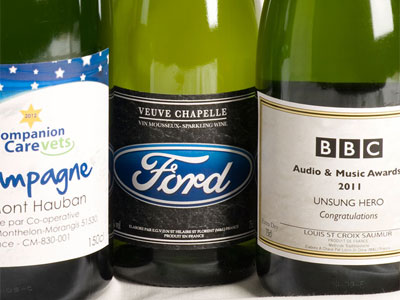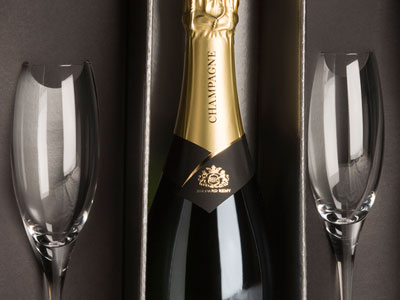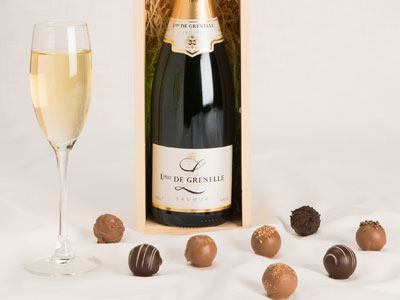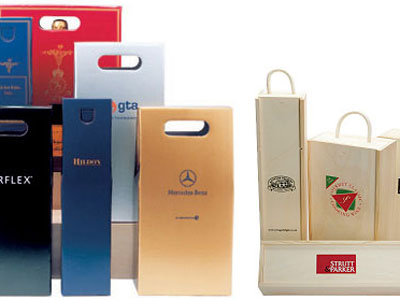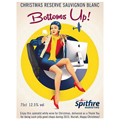Champagne labels are created to add decoration and information. By law, a Champagne label must display the origin of the Champagne to guarantee the wine’s authenticity and quality. This guide will explain the terms on the front and back labels so you can learn more about the delicious Champagne inside your bottle.
Here are the main statements every Champagne label must display and what they mean:
- Champagne – this has to be on the label (otherwise the wine is not Champagne). This is a guarantee to the buyer that the wine is from the Champagne region and is produced according to strict rules.
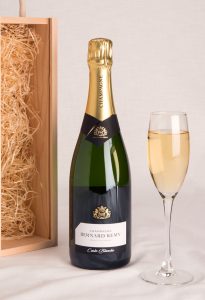 Brand – the name or trademark of the Champagne or Champagne house. This is the label of one of the Champagnes we offer in our range at Wines Select. It’s an award-winning Champagne, from Bernard Remy, and you can see this Champagne house named clearly on the label. Carte Blanche is the name of this particular blend, known as the ‘cuvee’. The cuvee in this instance is composed of 60% Pinot Noir, 35% Chardonnay and 5% Meunier.
Brand – the name or trademark of the Champagne or Champagne house. This is the label of one of the Champagnes we offer in our range at Wines Select. It’s an award-winning Champagne, from Bernard Remy, and you can see this Champagne house named clearly on the label. Carte Blanche is the name of this particular blend, known as the ‘cuvee’. The cuvee in this instance is composed of 60% Pinot Noir, 35% Chardonnay and 5% Meunier.- Volume of bottle – the amount of wine inside the bottle in centilitres or millilitres: 37.5cl or 350ml, 75cl or 750ml, and so on.
- ABV or alc/vol – this is the percentage of alcohol content, which is about 12% for Champagne.
- Country of Origin – this needs to say France, as Champagne can only be made in France.
- The name of the winemaker (élaborateur) and the name of the place where the Champagne was made (commune d’élaboration) written in full or as a code number.
- Official registration number – a code of two letters and a registration number. The two letters identify the producer and the registration number is the producer’s unique number given by the CIVC (Comité Interprofessionnel du Vin de Champagne). The CIVC is the governing body of Champagne. The two initial letters indicate the category of each producer and how they source the grapes for their wine.
-
The main categories of producer codes are:
- CM – Co-operative de manipulation – grapes are collected from several vineyards in the area and mixed together.
- RM Récoltant-Manipulant, a winemaker who makes and markets their own-label Champagne exclusively from grapes they grow themselves.
- NM Négociant-Manipulant, an individual producer or a Champagne House, with or without their own vines, who buy in grapes from other Champagne growers to produce their product. Many of the large Champagne houses fall into this category. They buy grapes in bulk to make their own Champagne.
- CM Coopérative de Manipulation, a cooperative of growers that make and market wine under the brand name of the co-op.
- RC Récoltant-Coopérateur, a grower who places their own labels on co-op produced wines.
- ND for Négociant Distributeur: This is when a wine merchant sells Champagne under their own brand name but the Champagne comes from other producers.
- MA Marque d’Acheteur, a brand of Champagne owned by a third party who is not the grower or producer, such as a restaurant or supermarket chain.
- SR for Société de Récoltants: A group of growers who share resources to produce Champagne.
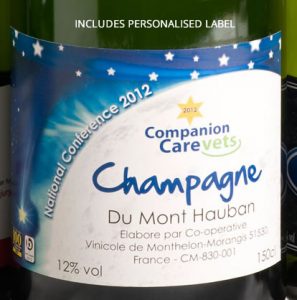 On this personalised label of one of our other Champagnes, Mont Hauban is the Champagne house. On the bottom right of this Champagne label you can see the code CM. This stands for Cooperative-Manipulant, which is when a group of small growers blend their grapes collectively to produce a sparkling wine under one or more brands. In this instance, the Cooperative of Monthelon-Morangis was created in 1947 when vine growers from two neighbouring villages came together to protect their work.
On this personalised label of one of our other Champagnes, Mont Hauban is the Champagne house. On the bottom right of this Champagne label you can see the code CM. This stands for Cooperative-Manipulant, which is when a group of small growers blend their grapes collectively to produce a sparkling wine under one or more brands. In this instance, the Cooperative of Monthelon-Morangis was created in 1947 when vine growers from two neighbouring villages came together to protect their work.
- Champagne type – defined by the level of sweetness or dosage. This is the scale starting with the driest:
- Brut nature – bone dry with no added sugar
- Extra Brut – ultra dry between 0 and 6g of sugar per litre
- Brut – very dry less than 12g of sugar per litre and the most common type of Champagne.
- Extra Sec – dry, between 12 and 17g of sugar per litre
- Sec – medium dry, between 17 and 32g of sugar per litre
- Demi Sec – sweet, 32 to 50g of sugar per litre
- Doux – sweetest, more than 50g of sugar per litre.
- Allergy advice – mention of the Champagne containing sulphites. Sulphites occur naturally as well as being added for stabilisation.
The label may also display other optional information such as:
Vintage – a Champagne exclusively made from the grapes harvested in the year displayed on the label. Usually, vintage Champagne will only be produced in a particularly good vintage year. It has to be matured for at least three years before releasing. The front label will feature a date of the vintage year.
Non-Vintage – this term represents a blended grape juice from multiple vintages.
Cuvee – cuvee is the blend.
Blanc de Blancs: a cuvee made exclusively from white grapes, typically Chardonnay.
Blanc de Noirs: a cuvee made only from red grapes (Pinot Noir or Pinot Meunier).
The majority of Champagne is made with a blend of Chardonnay, Pinot Noir and Pinot Meunier grapes
Vineyard classification – Cru is the word used to rank the quality of vineyards belonging to different Champagne villages. Very few villages are rated 100%. Grand Cru is the top tier and indicates a wine exclusively produced from vineyards rated 100% on the Echelle des Crus (scale of growths). Premier Cru is the second tier and indicates a wine exclusively produced from vineyards rated 90-99% on the Echelle des Crus.
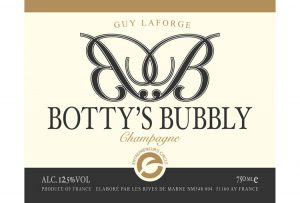 Design your own bespoke personalised Champagne label
Design your own bespoke personalised Champagne label
A luxury Champagne bottle beautifully personalised with your company logo on the label is a prestigious way to promote your brand or business. At Wines Select we can create a bespoke full-colour personalised Champagne label tailored to your specific requirements.
The front label of your Champagne can be branded with your logo and personalised for any occasion. Whether you want to celebrate an achievement or anniversary, thank clients or staff or enhance an event, a customised Champagne label is an elegant way to get your message across. You will be assured of the exceptional quality of the Champagne as we only customise the front label. The back label describing all the details of the Champagne stays the same.
For more information on creating your own bespoke branded Champagne label please call us on 0330 133 5135 or email sales@winesselect.co.uk

